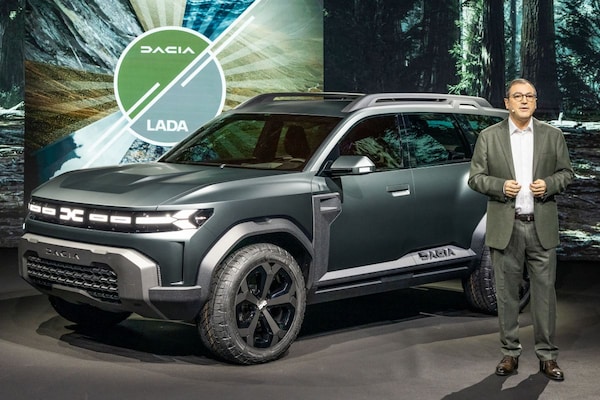
The Dacia Spring is a very affordable EV with which the brand wants to make a difference. Led by new-fangled CEO Denis le Vot, Dacias don’t always stay dirt cheap, but come close to the core of driving. What that means exactly, he explained to us at the IAA at the launch of the Jogger seven-seater, which, together with the electric Spring, is launching a new product offensive.
With the Spring, Dacia now offers the cheapest EV in Europe. How was he received?
“Considering the 25,000 orders we have in our order books, very good. The first shipment is currently docking in Italy, where deliveries will start soon. As you know, with Dacia we only enter segments where we can make a difference. The Spring does that in the A segment with the platform of the Kwid – a city car we developed for India – and the electric powertrain of the Renault City K-ZE from China. The result is a compact but also light EV that can use a small electric motor of 45 hp. That is a handy combination in countries with busy city centers.”
Don’t you fear that a range of 170 km is a bit meager?
“I didn’t say you have to cross Europe with it, did you (laughs). But seriously: in the EU still 2.1 million people with an A-segment commute between the crèche, the school and the supermarket. Many of those cars will not get a successor, because European legislation makes the engines too expensive and also too large to fit in a compact city car. Add to that the fact that such cars only travel 21 km per day on average, and 170 km does not seem so little at all. In addition, many families have a second and sometimes even a third car in the garage for longer journeys, so the Spring does not have to be so sophisticated. Also, don’t forget that the asking price of €17,890 in many markets is still €5,000 to €7,000 through subsidies and the like, which makes our offer completely crazy.”

CEO Denis le Vot at the Dacia Jogger
Does Dacia no longer necessarily want to be the cheapest?
“Indeed. All car manufacturers are faced with rising prices due to the obligation to build safer and greener cars. But I want to go even further than ‘no longer being the cheapest’. Because whoever manages to reduce his models to the core of the matter, instead of simply plucking them bare, is on the right track. The Sandero is a good example of this, the B-segmenter that has made it to the best-selling car in Europe. So why wouldn’t we be able to do that with a C-segment car? ‘The bigger the car, the higher the price’, is the logic normally. Well, we want to prove that we can make a difference in that class too. Which brings us to our new Jogger, a seven-seater that is still on the CMF-B platform. Normally you would have to buy 350 to 400 kg of car for that many seats, which would of course make it considerably more expensive. The Jogger weighs only 1,200 kg and can therefore suffice with the well-known 1-litre engine that guarantees a range of 1,100 km on LPG. In addition, it emits only 121 grams of CO2, at a purchase price just under €15,000. I call that reducing to the core.”
With the introduction of the Jogger comes the announcement that Dacia will apply hybrid technology.
“We will indeed do that from 2023, although we will again limit ourselves to the essentials. The E-Tech hybrid in the Jogger, although fully-fledged and therefore not of the mild kind, will soon be one without a plug. In principle, we could already offer these today, but we are consciously not doing that. We thoroughly investigate what is needed at the moment, taking into account the legislation. In addition, the price of the E-Tech hybrid engine goes down once production is running at full throttle, which is of course ideal for a brand like Dacia. That’s just how our group works: Renault starts off, Dacia distills the core from that.”

And what happens to Lada, who is also in your care? Are we going to see this brand return in Western Europe?
“You should not take that statement of our CEO Luca de Meo too literally. In a way, Dacia is doing the same in Europe as Lada in Russia: back to basics, not too expensive, with the right content and more solid in nature. In addition, Lada has a complex history, with product cycles that easily take ten years and that use a different platform each time. In other words, the logic is a bit lost there. Our CMF-B platform could be a handy solution for Lada. Not that our European customers will notice, any more than Lada will suddenly claim an important place in Europe. But it is important that we can add about 400,000 Ladas to the 600,000 Dacias on an annual basis, which of course benefits the economies of scale.”
Does that also apply to the Niva, the only Lada that does appeal to the imagination here?
“The Niva is a special case. That is why we are investigating whether and how we can bring that 4×4 icon back to Europe, which is of course in line with the Euro 7 emission rules from 2025. Some analysts think that we will combine the new Niva with the Bigster, but that is not correct. The Dacia Bigster will rather become a large and comfortable cruiser, while the Duster will remain in its current position. The new Niva should be shorter than our popular SUV, but also higher and of course equipped with high and low gearing. Whether all that will work under the new rules remains to be seen. But what is certain is that we will do our utmost to make it work.”
– Thanks for information from Autoweek.nl